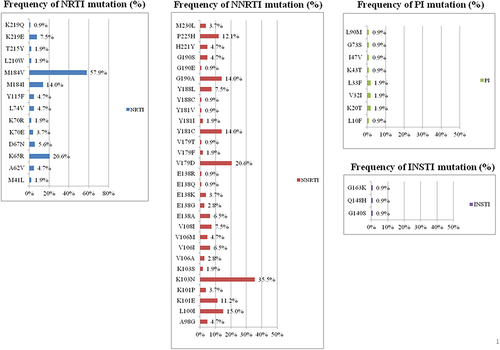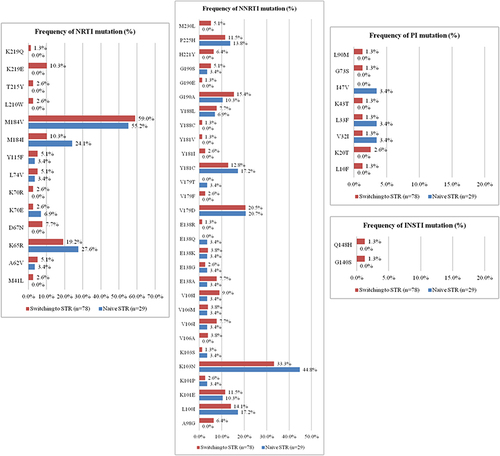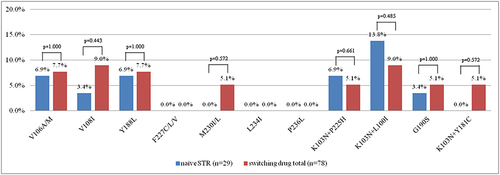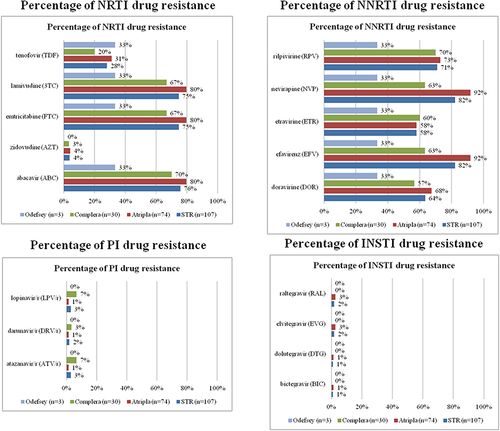Abstract
Purpose
This study aimed to investigate the prevalence of resistance to a non-nucleoside reverse transcriptase inhibitor (NNRTI)-based single-tablet regimen (STR) in Taiwanese patients and clarify the clinical implications of using doravirine in patients who fail NNRTI treatment.
Patients and Methods
Taiwanese patients infected with HIV-1 who failed NNRTI-based STR treatment were enrolled in this retrospective cohort study from 2015 to 2020. Mutations associated with drug resistance were identified using the 2019 International Antiviral Society-USA list of drug-resistant mutations in HIV, and drug susceptibility was assessed according to the Stanford HIV Drug Resistance Database version 9. Median values of continuous variables were compared between two groups using the Mann–Whitney U-test, and categorical variables were compared using the chi-square test or Fisher’s exact test.
Results
A total of 107 patients were included, of whom 29 were treatment failure to the initial STRs, and 78 failed treatment after switching to an STR. Seventy-four patients failed treatment with TDF/FTC/EFV (Atripla), 30 with TDF/FTC/RPV (Complera) and 3 with TAF/FTC/RPV (Odefsey). The prevalence rates of resistance to nucleoside reverse transcriptase inhibitors (NRTIs), NNRTIs, protease inhibitors (PIs) and integrase strand transfer inhibitors (INSTIs) were 76%, 86%, 3% and 2%, respectively. Among the 29 patients failure to the initial STRs, 62% developed doravirine resistance, compared to 64% of the 78 the patients who failed treatment after switching to an STR. There were no significant differences in the prevalence of specific NNRTI or doravirine resistance-associated mutations between these two groups. The patients with K65R mutations were more likely to have NNRTI resistance (p = 0.037) and doravirine resistance (p < 0.001).
Conclusion
Our findings showed a high rate of doravirine cross-resistance in patients with NNRTI-based STR treatment failure. Doravirine should be used cautiously as a salvage regimen in patients who fail NNRTI treatment.
Introduction
Doravirine is a new generation non-nucleoside reverse transcriptase inhibitor (NNRTI) which has been shown to be clinically effective for patients with K103N and G190A NNRTI mutations.Citation1 When used in combination with tenofovir and lamivudine as a single-tablet regimen (STR), doravirine has been shown to have a non-inferior efficacy and safety profile compared with efavirenz- and darunavir-based regimens for patients who have not previously received antiretroviral treatment (ART)Citation2,Citation3 or to replace the current ART regimen in those who are virologically suppressed.Citation4 Resistance to doravirine can develop and has been associated with the number of NNRTI resistance-associated mutations even without previous exposure. Previous in vitro multisite-directed mutagenesis studies have shown substantial cross-resistance to doravirine in NNRTI-resistant viruses, and significant increases in median fold change values with an increasing number of NNRTI resistance-associated mutations.Citation5
STRs have been associated with better drug adherence,Citation6 decreased risk of resistance mutations,Citation7 and improved quality of life compared to multiple-tablet regimens.Citation8 However, the prevalence of doravirine cross-resistance after STR failure is unknown. Most previous studies of NNRTI failure have been conducted in low-income countries where efavirenz- or nevirapine-based regimens were used as first-line treatment.Citation9 Therefore, this study aimed to investigate the prevalence of resistance to an NNRTI-based STR in Taiwanese patients and clarify the clinical implications of using doravirine in patients who fail NNRTI treatment.
Materials and Methods
Ethics Statement
The Institutional Review Board of Kaohsiung Veterans General Hospital, Taiwan, approved this study (VGHKS17-CT8-14), which was conducted according to the Declaration of Helsinki. In addition, all of the study subjects signed the written informed consent and all the participants had their records used in this study.
Study Design and Participants
This retrospective cohort study enrolled individuals residing in southern Taiwan, who were infected with HIV-1 and failed treatment with an NNRTI-based STR from 2015 to 2020. Briefly, the inclusion criteria included those patients with virological failure to NNRTI-based STRs and underwent an HIV genotypic drug resistance testing at our hospital. The definition of virological failure was an HIV-1 viral load of ≥1000 copies/mL.Citation10 The enrolled patients attended regular follow-up visits at our outpatient department, during which they were tested for viral load, CD4+ T cell count, biochemistry and hematology. The visits were scheduled for every 3 months during the first year after the diagnosis of HIV, and thereafter every 6 months in the stable patients. Combination antiretroviral therapy (cART) is provided to all individuals infected with HIV-1 at no cost by the Taiwanese government. AAlthough the cost of genotypic drug resistance testing is not reimbursed in Taiwan, the pretreatment and virological failure drug resistance testings are not mandatory and are only done at the clinician’s discretion. However, blood samples of patients with virological failure can be sent to a local research laboratory and the Taiwan Centers for Diseases Control on request. Before June 2016, the first-line cART regimens were restricted to zidovudine/lamivudine (ZDT/3TC) plus nevirapine (NVP) or efavirenz (EFV) due to financial constraints. However, after June 2016, the criteria for reimbursement were revised, and subsequently all treatment-naïve patients infected with HIV-1 were able to receive an STR. Efavirenz/emtricitabine/tenofovir disoproxil fumarate (Atripla) became available in Taiwan in 2010, and in June 2016, it was recommended as the first-line cART regimen. Other recommended first-line cART regimens available in Taiwan include abacavir/dolutegravir/lamivudine (Triumeq) and emtricitabine/rilpivirine/tenofovir disoproxil fumarate (Complera) also in June 2016, elvitegravir/cobicistat/emtricitabine/tenofovir alafenamide (Genvoya) in September 2018, bictegravir/emtricitabine/tenofovir alafenamide (Biktarvy) and rilpivirine/emtricitabine/tenofovir alafenamide (Odefsey) in October 2019, and doravirine/lamivudine/tenofovir disoproxil fumarate (DOR/3TC/TDF) and dolutegravir/lamivudine (Dovato) in December 2020. Of these, Odefsey, Complera and Atripla were the only NNRTI-based STRs at the time of conducting the study. In general, most of the HIV-1-infected treatment-naïve patients (80%) were initiated with an INSTI-based STR and 20% with an NNRTI-based STR in Taiwan.
Genotypic Drug Resistance Testing
ViroSeq HIV-1 Genotyping System version v2.8 (Celera, Alameda, CA, USA) was used to test resistance for PR/RT (pol gene), and in-house sequencing was used to test resistance to integrase strand transfer inhibitors (INSTIs) (pol gene).Citation11,Citation12 The International Antiviral Society (IAS)-USA 2019 mutation listCitation13 was used to define the clinically relevant mutations associated with drug resistance to nucleoside reverse transcriptase inhibitors (NRTIs), INSTIs, protease inhibitors (PIs) and NNRTIs. For the doravirine resistance-associated mutations, V106A/M/I/T, Y188L/C/H, G190E, P225H, F227C/L/R, M230L and L234I were considered to be significant as described by the IAS-USA 2019 mutation list.Citation13 The Stanford University HIV Drug Resistance Database (version 9, last update 2021-2-22) was used to assess resistance and subtypes. The patients with low, intermediate and high resistance were all classified as having drug resistance.Citation14
Statistical Analysis
Comparisons of median values of continuous variables between groups (resistant and wild-type virus) were performed using the Mann–Whitney U-test. Categorical variables were compared between two groups (mutations or resistance) using the chi-square test or Fisher’s exact test. A two-sided p value of less than 0.05 was considered to be statistically significant. All statistical analyses were conducted using SPSS version 12.0 (SPSS Inc., Chicago, IL).
Results
Of the 107 enrolled patients, 74 had virological failure to TDF/FTC/EFV (Atripla), 30 to TDF/FTC/RPV (Complera), and three to TAF/FTC/RPV (Odefsey). The median age (interquartile range, IQR) of the 107 patients was 33 (28–40) years with male predominant (96%) and 92% were men who have sex with men. The prevalence rates of hepatitis A, B and C infections were 11%, 14% and 6%, respectively. The median CD4 cell count (IQR) was 231 (91–411) cells/µL, and the median viral load (IQR) was 4.6 (4.2–5.1) log at time of genotyping. The median (IQR) duration on highly active antiretroviral therapy (HAART) was 18 (8–46.5) months, and the median (IQR) duration of the current failed regimen was 6 (3–12) months. The initial regimen when HIV was diagnosed was STR in 39 (36.4%) patients, NNRTI-based multiple-tablet regimen (MTR) in 54 (50.5%) patients, PI-based MTR in 12 (11.2%) patients and INSTI-based MTR in two (1.9%) patients. The median (IQR) frequency of switching regimen before switching to the current STR was 1 (0–2). The last regimen before switching to the current STR (n=78) was STR in 17 (21.8%) patients, NNRTI-based MTR in 47 (60.3%) patients, PI-based MTR in 11 (14.1%) patients and INSTI-based MTR in 3 (3.8%) patients. The detailed demographic and medication histories are summarized in .
Table 1 Demographic Data of the 107 HIV-1-Infected Patients with NNRTI-Based STR Treatment Failure
The demographic, treatment and resistance profiles between the 29 patients with treatment failure to the initial NNRTI-based STRs and 78 patients who switched to an STR (also including patients who switched from one STR to another STR) and subsequently failed STR treatment are shown in . There were no significant differences in demographic data between the two groups. The 29 patients who failed to the initial STRs were more likely to use Atripla (p=0.02, aHR 3.699, CI 1.170–11.694) and to have a shorter duration on highly active antiretroviral therapy (HAART) (median 10 months, IQR 3.8–14.8 months) compared to the 78 patients who switched (median 28.5 months, IQR 10–71.4 months) (p<0.001). The risk factors for doravirine resistance are shown in . There were no significant differences in age, risk factors for HIV infection, CD4, viral load, HIV subtype, duration on HAART and the current failed regimen between those with and without resistance.
Table 2 Demographic, Treatment and Resistance Differences Between the 29 Patients Who Failed to the Initial STR and 78 Patients with Virological Failure After Switching to STRs in Univariate Analysis
Table 3 Risk Factors Associated with Doravirine Resistance in Univariate Analysis
Among the 107 patients, only 8 underwent pretreatment genotypic resistance testing, and they all had the wild type. Sanger sequencing successfully identified the PR/RT (n=107) and INSTI (n=12) regions in all cases. Five of the 12 patients who underwent INSTI resistance testing had previous exposure to INSTIs. Overall, 89% of the patients had subtype B HIV-1 strains and 7% had subtype CRF01_AE (). The prevalence rates of NRTI, NNRTI, PI and INSTI drug resistance-associated mutations were 76%, 88%, 5% and 2%, respectively (). The distribution frequencies of NRTI, NNRTI, PI and INSTI mutations are shown in . The most common NRTI resistance-associated mutations were M184V (57.9%) and K65R (20.6%); for NNRTIs K103N (35.5%), V179D (20.6%) and L100I (15%); for PIs L33F (1.9%), K20T (1.9%) and V32I (1.9%); and for INSTIs G148H (0.9%) and G140S (0.9%). Differences in prevalence of mutation point between the 29 patients who failed to the initial STRs and 78 who failed treatment after switching to STRs are shown in . There were no significant differences in the percentage of specific doravirine resistance-associated mutations between these two groups (). The prevalence rates of NRTI, NNRTI, PI and INSTI drug resistance were 76%, 86%, 3% and 2%, respectively. Overall, 88% of the patients had resistance to any one of the four classes of cART (). The rates of resistance to individual antiretroviral drugs are shown in . Overall, 28% of the 107 patients had resistance to tenofovir (TDF), 4% to zidovudine (AZT) and 64% to doravirine. Among the 68 patients (64%) with doravirine cross resistance, the high-level resistance was 32.4% (22/68), intermediate resistance 48.5% (33/68) and low-level resistance 19.1% (13/68).
Figure 1 Rates of mutations associated with resistance to INSTIs, PIs, NNRTIs and NRTIs among the 107 enrolled patients with HIV-1 infection and virological failure to STRs. Overall, 88% of the patients had mutations associated with drug resistance to any of the four classes of antiretroviral drugs, including 88% with resistance to NNRTIs, 76% to NRTIs, 5% to PIs and 2% to INSTIs.

Figure 2 The prevalence of mutations associated with drug resistance to INSTIs, PIs, NNRTIs and NRTIs among the 107 enrolled patients with HIV-1 infection and virological failure to STRs. The most common mutations associated with resistance to NRTIs were M184V (57.9%) and K65R (20.6%); for NNRTIs K103N (35.5%), V179D (20.6%) and L100I (15%); for PIs L33F (1.9%), K20T (1.9%) and V32I (1.9%), and for INSTIs G148H (0.9%) and G140S (0.9%).

Figure 3 Differences in prevalence of mutation point between 29 patients who failed to the initial STRs and 78 patients with failure after switching to STRs.

Figure 4 The prevalence of doravirine resistance-associated mutations are shown according to the IAS-USA 2019 HIV drug resistance-associated mutation list. There were no statistically significant differences in the percentage of specific doravirine resistance-associated mutations between the 29 patients who failed to the initial STRs and 78 treatment failures after switching to STRs.

Figure 5 Prevalence rates of resistance to INSTIs, PIs, NNRTIs and NRTIs among the 107 enrolled patients with HIV-1 infection and virological failure to STRs. Overall, 88% of the patients had drug resistance to any of the four classes of antiretroviral drugs, including 86% who had resistance to NNRTIs, 76% to NRTIs, 3% to PIs and 2% to INSTIs.

Figure 6 The prevalence of drug resistance to NRTIs, NNRTIs, PIs and INSTIs among the 107 enrolled patients with HIV-1 infection and virological failure stratified by different NNRTI-based STRs. The figure shows that a total of 28% of 107 patients resistance to tenofovir (TDF), 4% to zidovudine (AZT) and 64% to doravirine.

There was no significant difference in the prevalence of doravirine resistance between the 29 initial STR failure patients and 78 patients who failed treatment after switching to STRs (62% vs 64%, p=1.000). The risk factors for K65R mutations are shown in . The patients with K65R mutations were more likely to have NNRTI (p=0.037) and doravirine (p<0.001) resistance compared to those without K65R mutations.
Table 4 Risk Factors Associated with the K65R Mutation in Univariate Analysis
Discussion
In this study, we found high rates of NRTI (76%) and NNRTI (86%) resistance among the 107 patients with NNRTI-based STR treatment failure. Overall, 64% of the patients had cross-resistance to doravirine despite not having used it before. In addition, the patients with K65R mutations were more likely to have NNRTI resistance (p=0.037) and doravirine resistance (p<0.001).
In the Italian Antiviral Response Cohort Analysis (ARCA) database,Citation15 researchers enrolled patients who had genotypic resistance tests before and after NNRTI-based cART treatment since 1999. The analysis showed that 12.7% and 6.1% of the NNRTI-experienced patients had intermediate and high-level resistance to doravirine, respectively. In a database of seven HIV genotypic drug resistance testing reference laboratories in France and Italy, a total of 9199 HIV-1 reverse transcriptase sequences were obtained from 2012 to 2017 from HIV-1 antiretroviral-experienced patients. Analysis of the database showed that the prevalence of sequences with at least one doravirine-associated resistance mutation was 34.9% in the patients who failed NNRTI treatment if V106A/M, V108I, Y188L, G190S, F227C/L/V, M230I/L, L234I, P236L, K103N + Y181C, K103N + P225H and K103N + L100I were considered to be doravirine-associated resistance mutations.Citation16
In a cross-sectional HIV drug resistance study conducted in Zambia, researchers enrolled young adults aged 15 to 24 years with virological failure after at least 6 months of antiretroviral therapy. They found that the prevalence rates of at least one HIV drug resistance-associated mutation to NRTIs, NNRTIs and PIs were 81%, 65.5% and 1.7%, respectively. Interestingly, there were relatively high prevalence rates of the NNRTI mutations V106A (36.2%), Y188C/L (36.2%) and P225H (20.7%), which conferred resistance to etravirine. Although they did not analyze the prevalence of doravirine resistance, the high prevalence of Y188 C/L mutations (36.2%) conferred high-level resistance to doravirine according the Stanford University HIV db Program (HIV db version 9, last updated on 2021-02-22)Citation14.A possible reason could be related to cross-resistance with nevirapine and efavirenz, which are widely used as first-line ART and prevention of mother-to-child transmission (PMTCT) programs.Citation17
In a study conducted in South Africa, Steegen et al reported rates of predicted intermediate and high-level resistance of 41% and 43.8% to doravirine, respectively, among 1372 patients who failed NNRTI-based ART when using the less stringent Stanford HIVdb v8.9 resistance interpretation criteriaCitation9 (in which the V106I mutation was considered to confer resistance) compared to the Stanford HIVdb v9.0 criteria. However, none of the aforementioned studies reported on how many patients used STRs.
The possible explanation for the high prevalence of doravirine resistance in our patients who failed NNRTI-based STR may be multifactorial. The K65R mutation was associated with a higher risk of NNRTI and doravirine resistance in this STR study. It is possible that the physicians chose the patients with poor drug adherence and prolonged failure with cumulative resistance for genotypic drug resistance testing, because access and reimbursement for such testing is limited in Taiwan. In addition, virological failure was defined as a single viral load >1000 copies/mL instead of >50 copies/mL or 200 copies/mL. This may have resulted in the selection of patients without adequate drug adherence rather than those with transient viral blips. Another possible explanation may be that the patients were taking STRs and so they could not choose to only take part of their medication. All of these explanations may have contributed to the high association between K65R and NNRTI resistance.
The high prevalence of doravirine resistance in this study was not derived from the presence of the V106I mutation in either our initial STR failure patients (7.7%) or those who failed treatment after switching to an STR (3.4%). The mutational score for V106I was only 10, which is considered to be susceptible in the Stanford HIVdb v9.0 resistance interpretation criteria used in this study. The Stanford HIVdb program scores individual mutations from 5 to 60, and a mutational score of >15 is considered to indicate resistance. In the Stanford University HIVdb version 8.7 (available at https://hivdb.stanford.edu/hivdb), V106I has a score of 15,Citation18 whereas the score is 10 in version 9 (last update 2021-2-22). Therefore, the presence of the V106I mutation and not combined with other NNRTI drug resistance-associated mutations would be less likely contribute to the high prevalence of doravirine resistance in this study.
In our previous study, we enrolled a total of 224 HIV-infected, treatment-naïve patients and found prevalence rates of NRTI, NNRTI, PI and INSTI resistance of 4%, 5.8%, 0.4% and 0.9%, respectively.Citation19 The doravirine-associated resistance was less than 2%. It is therefore reasonable that the high prevalence rate of doravirine resistance may have come from cross-resistance due to the previous exposure to NNRTIs and also de novo resistance because of prolonged failure to NNRTI-based STRs rather than the occurrence of transmitted drug resistance to doravirine.
There are several limitations to this study. First, pretreatment genotypic drug resistance testing was only available in eight patients. The impact of transmitted drug resistance to NNRTI was hard to evaluate despite the presence of low rate of transmitted drug resistance to doravirine in our previous study.Citation19 Second, relatively few of the HIV-1-infected patients received genotype resistance testing after failing treatment. Only patients with a viral load of >1000 copies/mL were enrolled, and we did not have data on the treatment outcomes after NNRTI-based STR failure. Third, the interpretation tool may have affected the prevalence of drug resistance-associated mutations. For example, for doravirine resistance-associated mutations, V106A/M/I/T, Y188L/C/H, G190E, P225H, F227C/L/R, M230L and L234I were considered to be significant in the IAS-USA 2019. Overall, 64% of the patients had resistance to doravirine. If the doravirine-associated mutations were defined as V106A/M, V108I, Y188L, F227C/L/V, M230I/L, L234I, P236L, K103N+ P225H, K103N+ L100I, K103N+Y181C and G190S as in the study by Soulie et al,Citation1 the expected prevalence of doravirine would be higher than in the present study.
Conclusion
We identified high rates of NRTI and NNRTI resistance in patients with virological failure to NNRTI-based STRs. The patients with K65R mutations were associated with doravirine resistance. Doravirine should be used cautiously as a salvage regimen in patients who fail NNRTI treatment.
Author Contributions
All authors made a significant contribution to the work reported, whether that is in the conception, study design, execution, acquisition of data, analysis and interpretation, or in all these areas; took part in drafting, revising or critically reviewing the article; gave final approval of the version to be published; have agreed on the journal to which the article has been submitted; and agree to be accountable for all aspects of the work.
Disclosure
The authors report no conflicts of interest in this work.
Additional information
Funding
References
- Wong A, Goldstein D, Mallolas J, et al. Efficacy and safety of doravirine/lamivudine/tenofovir disoproxil fumarate (DOR/3TC/TDF) in treatment-naive adults with HIV-1 and transmitted nonnucleoside reverse transcriptase inhibitor resistance mutations. J Acquir Immune Defic Syndr. 2019;82:e47–e49. doi:10.1097/QAI.0000000000002153
- Molina JM, Squires K, Sax PE, et al; DRIVE-FORWARD Trial Group. Doravirine versus ritonavir-boosted darunavir in antiretroviral-naive adults with HIV-1 (DRIVE-FORWARD): 96-week results of a randomised, double-blind, non-inferiority, Phase 3 trial. Lancet HIV. 2020;7:e16–e26. doi:10.1016/S2352-3018(19)30336-4
- Orkin C, Molina JM, Lombaard J, et al. Once-daily doravirine in human immunodeficiency virus type 1-infected, antiretroviral-naive adults: an integrated efficacy analysis. Clin Infect Dis. 2020;70:1344–1352. doi:10.1093/cid/ciz424
- Johnson M, Kumar P, Molina JM, et al; DRIVE-SHIFT Study Group. Switching to doravirine/lamivudine/tenofovir disoproxil fumarate (DOR/3TC/TDF) maintains HIV-1 virologic suppression through 48 weeks: results of the DRIVE-SHIFT trial. J Acquir Immune Defic Syndr. 2019;81:463–472. doi:10.1097/QAI.0000000000002056
- Saladini F, Giammarino F, Hosseini BA, et al. In vitro cross-resistance to doravirine in a panel of HIV-1 clones harbouring multiple NNRTI resistance mutations. J Antimicrob Chemother. 2021;76:130–134. doi:10.1093/jac/dkaa401
- Bangsberg DR, Ragland K, Monk A, et al. A single tablet regimen is associated with higher adherence and viral suppression than multiple tablet regimens in HIV+ homeless and marginally housed people. AIDS. 2010;24:2835–2840. doi:10.1097/QAD.0b013e328340a209
- Cotte L, Ferry T, Pugliese P, et al. Effectiveness and tolerance of single tablet versus once daily multiple tablet regimens as first-line antiretroviral therapy - results from a large French multicenter cohort study. PLoS One. 2017;12:e0170661. doi:10.1371/journal.pone.0170661
- Airoldi M, Zaccarelli M, Bisi L, et al. One-pill once-A-day HAART: a simplification strategy that improves adherence and quality of life of HIV-infected subjects. Patient Prefer Adherence. 2010;4:115–125.
- Steegen K, Moorhouse M, Wensing AM, et al. Is there a role for doravirine in African HIV treatment programmes? A large observational resistance study in South Africa. J Int AIDS Soc. 2021;24:e25706. doi:10.1002/jia2.25706
- Tsai HC, Chen IT, Wu KS, et al. High rate of HIV-1 drug resistance in treatment failure patients in Taiwan, 2009–2014. Infect Drug Resist. 2017;10:343–352. doi:10.2147/IDR.S146584
- Canducci F, Barda B, Ceresola E, et al. Evolution patterns of raltegravir-resistant mutations after integrase inhibitor interruption. Clin Microbiol Infect. 2011;17:928–934. doi:10.1111/j.1469-0691.2010.03375.x
- Canducci F, Ceresola ER, Boeri E, et al. Cross-resistance profile of the novel integrase inhibitor Dolutegravir (S/GSK1349572) using clonal viral variants selected in patients failing raltegravir. J Infect Dis. 2011;204:1811–1815. doi:10.1093/infdis/jir636
- Wensing AM, Calvez V, Ceccherini-Silberstein F, et al. 2019 update of the drug resistance mutations in HIV-1. Top Antivir Med. 2019;27:111–121.
- Stanford University HIV drug resistance database. Version 9.0. Available from: https://hivdb.stanford.edu. Accessed June 2, 2021.
- Sterrantino G, Borghi V, Callegaro AP, et al. Prevalence of predicted resistance to doravirine in HIV-1-positive patients after exposure to non-nucleoside reverse transcriptase inhibitors. Int J Antimicrob Agents. 2019;53:515–519. doi:10.1016/j.ijantimicag.2019.02.007
- Soulie C, Santoro MM, Storto A, et al. Prevalence of doravirine-associated resistance mutations in HIV-1-infected antiretroviral-experienced patients from two large databases in France and Italy. J Antimicrob Chemother. 2020;75:1026–1030. doi:10.1093/jac/dkz553
- Miti S, Handema R, Mulenga L, et al. Prevalence and characteristics of HIV drug resistance among antiretroviral treatment (ART) experienced adolescents and young adults living with HIV in Ndola, Zambia. PLoS One. 2020;15:e0236156. doi:10.1371/journal.pone.0236156
- Guerrero-Beltrán C, Martínez-Sanz J, Álvarez M, et al. The algorithm used for the interpretation of doravirine transmitted drug resistance strongly influences clinical practice and guideline recommendations. J Antimicrob Chemother. 2020;75:1294–1300. doi:10.1093/jac/dkaa009
- Tsai HC, Chen IT, Tsai KW, et al. Prevalence of HIV-1 integrase strand transfer inhibitor resistance in treatment-naïve voluntary counselling and testing clients by population sequencing and illumina next-generation sequencing in Taiwan. Infect Drug Resist. 2020;13:4519–4529. doi:10.2147/IDR.S273704
